| Don't miss the icons
in this article.  This one will take you to on the spot audio reports.
This one will take you to on the spot audio reports.  This one will show you the real stuff.
This one will show you the real stuff.
A feast for the senses, Québec City is the quintessential
traveller's destination. This unique walled city (the only one in
North America) reigns over the luxurious St. Lawrence Valley and
is a geographical phenomenon in itself.
A traveler's pilgrimage site, it is perched on a high promontory
that looks out over the history of North America. It was here that
First Nations people of Canada established a key trading post that
became increasingly important when the European visitors first arrived
in search of the the riches of the “New World” —
furs.
And then in 1608 it became the cradle of French civilization in
North America while English-speaking pilgrims were wending their
way to more southern climes known as Virginia. (The Old World Lower
Town is the site of this original settlement.)
Later in 1759, a 20-minute battle on the city's Plains of Abraham
would seal the fate of all of North America when two warring colonial
European powers went head to head and Britain emerged the winner.
This brief but historically tumultuous event, followed eventually
by a grab-and-run event called the Louisiana Purchase, separated
an English-speaking Petit Bonhomme from and French-speaking Grand
Bonhomme for four centuries. But today, this UNESCO World Heritage
site is one of North America's premier cultural meeting places.
Today the world comes to Québec City (nearly four million
visitors a year), and in 2006 so did a Petit Bonhomme from Sarasota.
Florida.
NOTE: Mark your calendars
for 2008 (any season will do) when Québec City celebrates
its 400th anniversary. Petit Bonhomme has promised to return to
help orchestrate the festivities.
 
Day one
of the second week of Carnaval. To avoid being mobbed by
his Québécois fans, Roy sneaks into town incognito,
dressed as a Rastafarian lumberjack. Always the intrepid traveller,
he makes his way through the woods to the Cabane à sucre
(Maple Sugar Shack) on a Norwegian sled.
Québec City is a world cultural capital, always host to
great performers from Édith Piaf to Bon Jovi, Metallica,
and Rush. And of course, the province of Québec's hometown-girl-made-good
Céline Dion ... or as they say in Québec, “Notre
petite Céline.” And it is a world-class capital in
many other respects. If you want to develop a premier reputation
as a chef, you must spend time in gourmet Québec. Here classic
cuisine meets traditional French North American cuisine and the
result is Nouvelle Cuisine Québécoise — voilà!
To the north are the Laurentians, some of the best skiing and other
winter nature-based activities in Eastern Canada. And on a clear
day you will see from the heights of Québec the Appalachian
foothills and mountains and Québec's New England cousins.
A hop skip, and a saut.
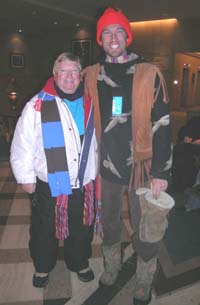 
Roy meets
one of his long-lost cousins, a coureur de bois. They bond
instantly and Roy, feeling the call of the wild in his blood, takes
up Carnival jogging. He becomes a role model of endurance for the
locals. (Until now he had thought he was primarily Irish. However
the common Celtic roots, DNA, and love of a good party are shared
by the first families of the French Régime in North America
and that other musical toe-tapping lot across the pond.)
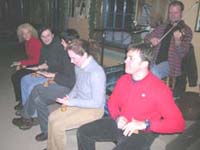
To celebrate
the arrival of the prodigal Bonhomme de Floride, the locals
bring out the fiddle and spoons and the fête begins.
Roy's blood stirs and he acquits himself admirably, demonstrating
he can dance as fast as he can talk. In the process he attracts the
attention of numerous demoiselles.

What is this Carnaval
de Québec?
In its 52nd year, the Carnaval is
North America's biggest winter Mardi Gras celebration, and the world's
biggest winter carnival. Québec likes to call itself “the
World's Snow Capital” and its geographic and climatic conditions
do indeed make for a real winter experience, none of that brown
slush that elsewhere passes for winter.
The first Carnival took place in 1894 and
of course was not only a celebration of winter but also a respite
from what were very harsh winter conditions in those “good
old days” / le bon vieux temps. The Carnival is also
a major cultural industry in Québec especially in the province's
capital Québec City. It is the largest Mardi Gras celebration
in the world after Rio de Janiero and New Orleans.
Le Carnaval de Québec may
well be Québec culture in its most vibrant and visitor-friendly
form. This three-week revelry that precedes Lent is 17 days of arts,
music, food, and outdoor athletic events that define the heart of
the more than six million French-speaking Québécois
in a province as big as France, Germany and Spain combined, a province
of Canada that borders on the U.S. states of Maine, New Hampshire,
Vermont, and New York.
The events of Carnaval embody the
historic traditions of the Catholic French Régime in North
America and today represent a substantial francophone cultural identity
and reality in North America. In the 2005 Carnival, one million
people took part in the celebrations, with an estimated direct economic
spin-off of between 20-30 million dollars. The Carnival's budget
is more than seven million dollars.
Carnaval and its global ambassador
Bonhomme (as I write he is in London promoting next year's Carnival),
are for many visitors from Canada and outside the country the first
experiential contact with what in Canada has been called “a
distinct society.” As a member of the Francophonie,
the global confederation of French-speaking nations and territories,
Québec is front and centre on the world stage.
Mardi Gras and Québécois
Culture
To a cultural anthropologist, le Carnaval is a living
laboratory in the evolution of a unique group of people. Many of
the elements — if not all — of human culture as we know
it can be experienced during the Carnival.
Culture is usually defined as an integrated system of values, beliefs,
and behaviour patterns that are acquired through the social evolution
of a people.
And when you participate in Carnaval (like all good hosts,
the Québécois are very inclusive in terms of Carnival
party-goers — the more the merrier) you experience the sense
of unity and common purpose — both physical and cultural survival
— that a harsh but grand climate, a prodigious natural setting,
and dramatic historical events have produced.
Reflecting its historical Catholic heritage, Québec's Carnival
is a unique representation of the celebrations in many countries
that precede the Lenten period beginning on “Fat Tuesday”
(Mardi Gras). During Lent, it is a traditional custom to apply personal
restraint and a temporary renunciation of the yummier things in
life — the ways of the flesh. (Carnival — carne
+ vale — means “Bye bye flesh/meat”).
And the period of Lent of course is the holiest time in the Christian
calendar: the time of rebirth and redemption.
The winters in Québec are long and snowy, but spring eventually
arrives. But before it does, why not make the best of it; and celebrate
the winter that not only you have survived but have worked and played
with.
One of the best-known songs in Québec is titled Mon
Pays (My Country). This definitive expression of the the soul
of the Québécois people celebrates in its refrain
both Québec itself and the winter with which the Québécois
identify with so strongly.
Mon pays ce n'est pas un pays, c'est l'hiver! (My country
is not a country, it is winter!)

Roy's
special status as an honorary (although petit) Bonhomme is recognized
when he is invited to ascend the ice throne. His regal bearing is
quite evident although his Floridian backside experiences some culture
shock.

One of
the most exciting events of the Carnival is the canoe race across
the St. Lawrence River with its rapidly flowing current and ice flows.
Teams from Canada and elsewhere compete in the gruelling race across
the river and back. Because of his extensive experience paddling through
the Everglades, Roy is asked to coach one of the women's team. He
is a tough task master but they love him all the more for it.


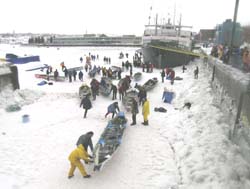

The
Ice Hotel and other Views of Québec
During
his visit to the Carnaval de Québec, Roy is given the keys
to the Ice Hotel, and as he has spent many years in the travel industry,
finds himself quite at home.

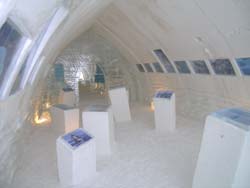







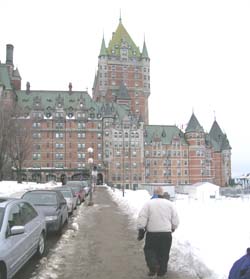

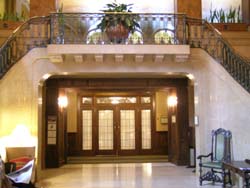


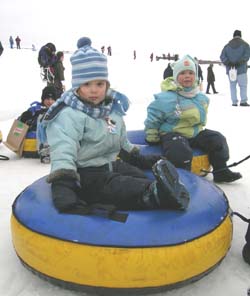


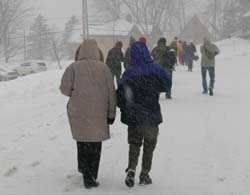


Roy
is invited by Bonhomme to help launch the second week of the Carnaval.
There is some initial language problem. Roy speaks English with A
new York and Floridian accent and Bonhomme (when speaking English)
speaks Canadian eh? But the launch goes off without a hitch.  |